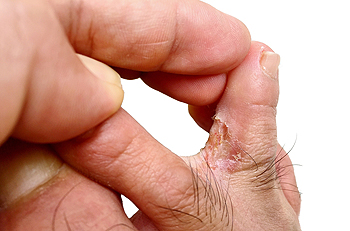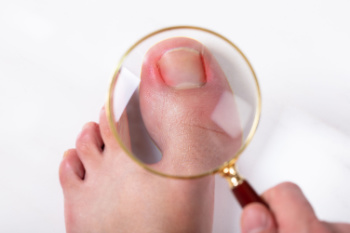
Big toe pain can be incredibly painful and disruptive, affecting your ability to walk or wear shoes comfortably. The pain can be caused by a number of factors, including injury, toenail problems, or gout. An injury to the big toe, such as a sprain or fracture, can cause throbbing pain, swelling, and difficulty moving the toe. Toenail issues, like ingrown toenails or fungal infections, can lead to sharp pain, redness, and tenderness around the nail. Gout, a type of arthritis, often targets the big toe, causing sudden, intense pain, swelling, and a feeling of heat, typically at night. Symptoms of big toe pain include sharp or throbbing pain, swelling, redness, or a decreased range of motion. A podiatrist can help by diagnosing the underlying cause of the toe pain through a physical exam and imaging tests. Treatment may include medication, proper footwear, toenail care, or even surgery for more severe cases. If you are dealing with big toe pain, it is suggested that you make an appointment with a podiatrist for a proper diagnosis and treatment.
Toe pain can disrupt your daily activities. If you have any concerns, contact the podiatrists of New England Family Foot Care. Our doctors can provide the care you need to keep you pain-free and on your feet.
What Causes Toe Pain?
Most severe toe pain is caused due to a sports injury, trauma from dropping something heavy on the toe, or bumping into something rigid. Other problems can develop over time for various reasons.
Toe pain can be caused by one or more ailments. The most common include:
- Trauma
- Sports injury
- Wearing shoes that are too tight
- Arthritis
- Gout
- Corns and calluses
- Hammertoe
- Bunions
- Blisters
- Ingrown toenails
- Sprains
- Fractures (broken bones)
- Dislocations
When to See a Podiatrist
- Severe pain
- Persistent pain that lasts more than a week
- Signs of infection
- Continued swelling
- Pain that prevents walking
Diagnosis
In many cases the cause of toe pain is obvious, but in others, a podiatrist may want to use more advanced methods to determine the problem. These can range from simple visual inspections and sensation tests to X-rays and MRI scans. Prior medical history, family medical history, and any recent physical traumatic events will all be taken into consideration for a proper diagnosis.
Treatment
Treatments for toe pain and injuries vary and may include shoe inserts, padding, taping, medicines, injections, and in some cases, surgery. If you believe that you have broken a toe, please see a podiatrist as soon as possible.
If you have any questions please feel free to contact our office located in Milton, MA . We offer the newest diagnostic tools and technology to treat your foot and ankle needs.

Athlete's foot is a fungal infection that affects the skin on the feet, typically beginning between the toes. It is caused by dermatophytes, a group of fungi that thrive in warm, moist environments such as locker rooms, public showers, and sweaty footwear. The infection spreads easily through direct contact or contaminated surfaces. Symptoms often include itching, burning, and stinging sensations, especially between the toes or on the soles. The affected skin may appear red, scaly, cracked, or may peel. In more severe cases, blisters or ulcers can form. Although athlete's foot is not usually serious, it can be persistent and uncomfortable without proper treatment. If you have symptoms of this irritating condition, it is suggested that you promptly consult a podiatrist who can begin effective treatment, which often includes prescribed medication.
Athlete’s foot is an inconvenient condition that can be easily reduced with the proper treatment. If you have any concerns about your feet and ankles, contact the podiatrists from New England Family Foot Care. Our doctors will treat your foot and ankle needs.
Athlete’s Foot: The Sole Story
Athlete's foot, also known as tinea pedis, can be an extremely contagious foot infection. It is commonly contracted in public changing areas and bathrooms, dormitory style living quarters, around locker rooms and public swimming pools, or anywhere your feet often come into contact with other people.
Solutions to Combat Athlete’s Foot
- Hydrate your feet by using lotion
- Exfoliate
- Buff off nails
- Use of anti-fungal products
- Examine your feet and visit your doctor if any suspicious blisters or cuts develop
Athlete’s foot can cause many irritating symptoms such as dry and flaking skin, itching, and redness. Some more severe symptoms can include bleeding and cracked skin, intense itching and burning, and even pain when walking. In the worst cases, Athlete’s foot can cause blistering as well. Speak to your podiatrist for a better understanding of the different causes of Athlete’s foot, as well as help in determining which treatment options are best for you.
If you have any questions please feel free to contact our office located in Milton, MA . We offer the newest diagnostic and treatment technologies for all your foot and ankle needs.

An ingrown toenail is more than a nuisance. It can quickly become a painful and persistent problem. When the nail’s edge presses into the skin, irritation follows. If ignored, this small issue can develop into an infection that impacts your ability to walk comfortably. Many factors contribute to ingrown toenails, including trimming nails too short, wearing shoes that squeeze the toes, and sustaining toe injuries. Some individuals are simply more prone to this condition due to the natural shape of their nails. Prevention often begins with simple habits, such as cutting toenails straight across and avoiding overly tight footwear. However, once an ingrown nail becomes inflamed or infected, professional care is the best option. If you are experiencing persistent toe pain or signs of infection, it is recommended that you see a podiatrist for a thorough evaluation and appropriate treatment.
Ingrown toenails can become painful if they are not treated properly. For more information about ingrown toenails, contact the podiatrists of New England Family Foot Care. Our doctors can provide the care you need to keep you pain-free and on your feet.
Ingrown Toenails
Ingrown toenails occur when a toenail grows sideways into the bed of the nail, causing pain, swelling, and possibly infection.
Causes
- Bacterial infections
- Improper nail cutting such as cutting it too short or not straight across
- Trauma to the toe, such as stubbing, which causes the nail to grow back irregularly
- Ill-fitting shoes that bunch the toes too close together
- Genetic predisposition
Prevention
Because ingrown toenails are not something found outside of shoe-wearing cultures, going barefoot as often as possible will decrease the likeliness of developing ingrown toenails. Wearing proper fitting shoes and using proper cutting techniques will also help decrease your risk of developing ingrown toenails.
Treatment
Ingrown toenails are a very treatable foot condition. In minor cases, soaking the affected area in salt or antibacterial soaps will not only help with the ingrown nail itself, but also help prevent any infections from occurring. In more severe cases, surgery is an option. In either case, speaking to your podiatrist about this condition will help you get a better understanding of specific treatment options that are right for you.
If you have any questions please feel free to contact our office located in Milton, MA . We offer the newest diagnostic and treatment technologies for all your foot and ankle needs.





